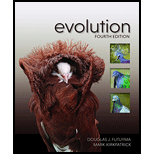
Concept explainers
To determine: The way in which the difference in use of characters might result in a discrepancy in classification.
Introduction: In taxonomy, nomenclature and classification of organisms along with the study of their evolutionary relationships are called systematics. In the mid-twentieth century, systematists had one of the two views. First, they believed in the classification of organisms merely on the basis of their morphological similarities. The other group considered division into monophyletic groups as a classifying factor as well.
To determine: The approach that is more commonly used today.
Introduction: In taxonomy, nomenclature and classification of organisms, along with the study of their evolutionary relationships are called systematics. In the mid-twentieth century, systematists had one of the two views. First, they believed in the classification of organisms merely on the basis of their morphological similarities. The other group considered division into monophyletic groups as a classifying factor as well.
Want to see the full answer?
Check out a sample textbook solution
- A critical concern of systematics is that the genera are , that all the species included in the genus are related to each other by a common ancestor, and that (circle one: all, most, at least half) of the descendants of that common ancestor are in the same genus. Such a genus is (circle one: polyphyletic, monophyletic).arrow_forwardWhich of the following is true regarding the way we define clades with characters? Select one: a. Autapomorphies are good characters to use because they describe every lineage of the clade and no other lineages b. Plesiomorphies are good characters to use because they describe every lineage of the clade and no other lineages c. Synapomorphies are good characters to use because they describe every lineage of the clade and no other lineages Please give me the correct answer quickly I will give you upvotearrow_forwardExamine the following phylogenetic tree illustrated in Figure shown in the first picture. In general, what does a phylogenetic tree illustrate? How do you compare the relationships of organisms BB, CC, and DD? Given the following organisms in the Table in the second picture, number them in terms of which is relatively closest and distant. Number 1 refers to closest.arrow_forward
- It is possible for two different genes to imply different phylogenetic relationships among a group of species. What are the possible reasons for this? If there is only one true history of formation of these species, what might we do in order to determine which (if either) gene accurately portrays that history? Is it possible for both phylogenetic trees to be accurate even if there has been only one history of species divergence?arrow_forwardPlease help If organisms D, E, and F belong to the same family but to different genera, and if organisms A, B, and C belong to the same order but to different families, which of the following pairs of organisms would be expected to have the greatest number of homologous characters? D and F C and F D and C B and D A and Barrow_forwardThe “kingdom” concept is considered out-of-date but most continue to use it in a revised manner. What are the traditional Linnaean taxonomic categories: Kingdom, phylum, ____________, ___________, ____________, _______________, species. When the traditional Linnaean taxonomic categories are not used, people can say “clade” or “taxon” for any genetic group.arrow_forward
- Below is a phylogenetic tree. Which of the following statements is correct? Species C and D are called sibling taxa because both are derived from the same parent species H. Species F is more related to species K than species D is. Species A, B, and D share a common ancestor of species I. All species shown are currently with us. All of the abovearrow_forwardWhich of the following is a problem with applying the phylogenetic species concept? Some individuals we think are different species can interbreed Some individuals look exceedingly similar Increased DNA sequencing could lead to different definitions of species No one knows how to make a phylogenyarrow_forwardWhat taxonomic practices based on the typological species concept are retained in systematics today? How has their interpretation changed?arrow_forward
- What different types of data are used to reconstruct phylogeny? What are the desirable properties of data used to reconstruct phylogeny?arrow_forwardDo you find it easy to interpret phylogenetic trees? What aspects are the most challenging or what aspects of the tree can be easily misinterpreted? What strategies can students use to correct or avoid these common misinterpretations? Do you consider phylogenetic trees to be reliable indicators of evolutionary relationships? Include a reference.arrow_forwardWhy would it be nice to have classification reflect phylogeny accurately that is, to only name monophyletic groupsarrow_forward
 Human Anatomy & Physiology (11th Edition)BiologyISBN:9780134580999Author:Elaine N. Marieb, Katja N. HoehnPublisher:PEARSON
Human Anatomy & Physiology (11th Edition)BiologyISBN:9780134580999Author:Elaine N. Marieb, Katja N. HoehnPublisher:PEARSON Biology 2eBiologyISBN:9781947172517Author:Matthew Douglas, Jung Choi, Mary Ann ClarkPublisher:OpenStax
Biology 2eBiologyISBN:9781947172517Author:Matthew Douglas, Jung Choi, Mary Ann ClarkPublisher:OpenStax Anatomy & PhysiologyBiologyISBN:9781259398629Author:McKinley, Michael P., O'loughlin, Valerie Dean, Bidle, Theresa StouterPublisher:Mcgraw Hill Education,
Anatomy & PhysiologyBiologyISBN:9781259398629Author:McKinley, Michael P., O'loughlin, Valerie Dean, Bidle, Theresa StouterPublisher:Mcgraw Hill Education, Molecular Biology of the Cell (Sixth Edition)BiologyISBN:9780815344322Author:Bruce Alberts, Alexander D. Johnson, Julian Lewis, David Morgan, Martin Raff, Keith Roberts, Peter WalterPublisher:W. W. Norton & Company
Molecular Biology of the Cell (Sixth Edition)BiologyISBN:9780815344322Author:Bruce Alberts, Alexander D. Johnson, Julian Lewis, David Morgan, Martin Raff, Keith Roberts, Peter WalterPublisher:W. W. Norton & Company Laboratory Manual For Human Anatomy & PhysiologyBiologyISBN:9781260159363Author:Martin, Terry R., Prentice-craver, CynthiaPublisher:McGraw-Hill Publishing Co.
Laboratory Manual For Human Anatomy & PhysiologyBiologyISBN:9781260159363Author:Martin, Terry R., Prentice-craver, CynthiaPublisher:McGraw-Hill Publishing Co. Inquiry Into Life (16th Edition)BiologyISBN:9781260231700Author:Sylvia S. Mader, Michael WindelspechtPublisher:McGraw Hill Education
Inquiry Into Life (16th Edition)BiologyISBN:9781260231700Author:Sylvia S. Mader, Michael WindelspechtPublisher:McGraw Hill Education





